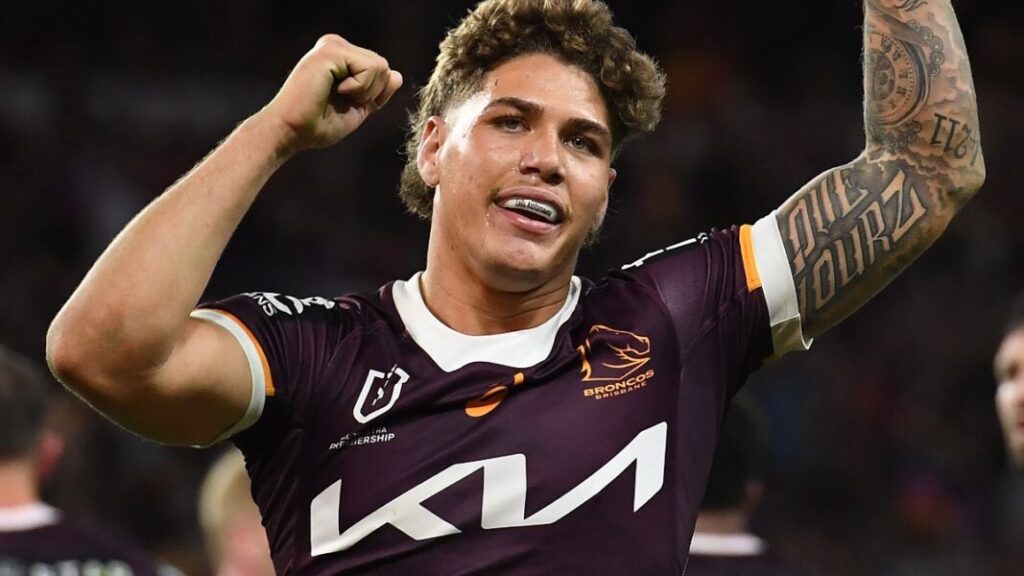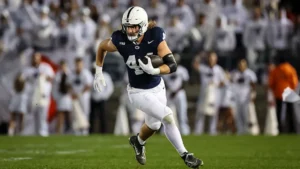
Not many like him! Reece Walsh’s $450,000 Salary Sacrifice: How His Financial Decision Enabled The Broncos To Sign Ben Hunt Amid Salary Cap Crunch…
Reece Walsh’s decision to remain on a contract worth $450,000 per year until 2025, despite being valued at approximately $1 million on the open market, significantly benefited the Brisbane Broncos amid their salary cap challenges.
This sacrifice helped the club manage its finances effectively while pursuing other key signings, including the potential acquisition of Ben Hunt.
The Broncos leveraged creative strategies to address salary cap constraints, such as offering Hunt a post-career role within the organization.
This allowed them to structure Hunt’s two-year contract at a reported $600,000 per season, well below his market value of up to $1.4 million elsewhere. The arrangement exemplifies how Walsh’s financial compromise enabled Brisbane to prioritize team composition and maintain competitiveness.
Walsh’s willingness to stay on a lower salary also set a collaborative tone for retaining other key players like Ezra Mam and Payne Haas, who are integral to the Broncos’ roster stability. This underscores the club’s broader strategy of cultivating loyalty among homegrown talent to achieve long-term success.
The Brisbane Broncos’ approach to managing their salary cap has been a mixture of strategic sacrifices by players like Reece Walsh and creative solutions to sign new talent, such as Ben Hunt. Walsh, who signed a $450,000 annual deal running through 2025, chose to stay at a lower salary despite being valued at double that on the open market.
This decision not only reinforced his commitment to the team but also provided financial flexibility for the Broncos to retain and recruit other key players.
Roster Retention and Recruitment Challenges:
1. Reece Walsh’s Sacrifice: Walsh’s decision was pivotal in retaining core players like Payne Haas and Ezra Mam. Both are integral to the Broncos’ future, and maintaining financial stability is crucial in securing their extensions.
2. Ben Hunt’s Signing: Hunt’s potential return to Brisbane on a deal reportedly worth $600,000 annually for two years was facilitated by a loophole in the salary cap. The club offered him a post-playing role, which allowed a portion of his contract to be classified outside the cap.
3. Upcoming Contract Expirations: The Broncos face a critical period with several key players’ contracts expiring soon. Managing extensions while staying within the cap will test their financial strategy. Players like Adam Reynolds, Kurt Capewell, and Selwyn Cobbo may require adjusted deals to remain in Brisbane.
Creative Cap Management:
The Broncos have leaned on innovative approaches, like the post-playing career role offered to Hunt, to remain competitive. This method enables the club to secure marquee players without exceeding salary cap limitations.
The club’s cost-efficient spine—consisting of Walsh, Billy Walters, and Reynolds—costs significantly less than their competitors’ setups. This provides a financial edge to invest in other parts of the roster.
Implications for the Future:
While Walsh’s sacrifice and Hunt’s discounted deal are short-term wins, sustaining success will depend on balancing player loyalty with financial realities. With the Broncos poised for success following their best ladder finish since 2015, maintaining this roster harmony will be vital for long-term dominance in the NRL.
Brisbane Broncos’ Salary Cap Strategy: A Deep Dive
The Brisbane Broncos have shown a masterclass in managing their salary cap amid challenges of retaining star players and acquiring marquee talent like Ben Hunt. This strategy combines player sacrifices, innovative financial maneuvers, and long-term planning.
1. Reece Walsh’s Impact on Cap Space
Reece Walsh’s $450,000 per annum contract is the cornerstone of the Broncos’ financial flexibility. Despite his market value being closer to $1 million, Walsh opted to prioritize team stability over personal earnings. This decision allowed the Broncos to reallocate funds toward other critical areas:
Retaining Key Players: Funds saved from Walsh’s deal contributed to extensions for Ezra Mam and Payne Haas. Both players are vital to the Broncos’ future, with Haas recognized as one of the NRL’s premier forwards.
Long-Term Viability: Walsh’s commitment sends a strong message to other teammates, fostering a culture of loyalty and shared sacrifice.
2. Signing Ben Hunt: The Loophole Advantage
The Broncos’ acquisition of Ben Hunt highlights their innovative cap management:
Dual Role Strategy: Brisbane reportedly structured Hunt’s deal at $600,000 per season, well below his market value of $950,000–$1.4 million. They leveraged an NRL rule allowing post-retirement roles to be excluded from the cap if properly documented. This enabled the Broncos to offer Hunt a post-playing career position within the organization.
Hunt’s Motivation: Hunt’s emotional connection to Brisbane, where he started his career, played a significant role in his willingness to accept a lower salary. His desire to finish his career with the Broncos was a critical factor.
3. Financial Pressure Points
The Broncos face multiple challenges that could impact their cap strategy:
Pending Extensions: Contracts for senior players like Adam Reynolds and Kurt Capewell, as well as rising stars like Selwyn Cobbo, will need to be addressed in the coming seasons. Retaining these players could strain the cap.
Competing Offers: Other clubs have significant financial firepower, as seen in Hunt’s offers from the Dolphins ($1.4 million over two years) and other Sydney-based clubs.
Balancing the Roster: The Broncos’ forward pack and spine are relatively cost-effective, but managing depth across the roster while staying competitive is a delicate balance.
4. Culture and Future Planning
The Broncos’ success isn’t just financial—it’s cultural:
Team Loyalty: Reece Walsh’s sacrifice and the club’s efforts to bring back Ben Hunt reflect a culture where players value success and team unity over maximum earnings.
Youth Development: The Broncos have consistently developed young talent like Walsh, Ezra Mam, and Payne Haas, reducing reliance on expensive external recruitment.
Championship Window: With a young core and strategic veterans like Hunt, the Broncos are positioned to compete for NRL titles in the coming years.
The Broncos’ approach to the salary cap combines player sacrifices, innovative structuring, and a strong emphasis on loyalty and youth development. While challenges remain, their ability to sign Ben Hunt and retain stars like Walsh and Haas demonstrates a winning formula that could keep Brisbane at the top of the NRL ladder for years.
Here’s a detailed comparison of the Brisbane Broncos’ salary cap strategies with other NRL clubs, focusing on creative financial management, key player retention, and strategic recruitment:
1. Brisbane Broncos: Balancing Youth and Veterans
Key Moves: Reece Walsh’s discounted $450,000 contract, Ben Hunt’s post-career role, and careful retention of Payne Haas and Ezra Mam highlight the Broncos’ focus on internal loyalty and innovative cap use.
Youth Development: The Broncos prioritize developing talent through their system, reducing reliance on high-cost external signings.
Cultural Edge: Walsh’s willingness to sacrifice higher earnings for team stability exemplifies the Broncos’ strong internal culture, making them a model for player-centric cap strategies.
2. Sydney Roosters: Leveraging TPA Agreements
Third-Party Agreements (TPAs): The Roosters are known for utilizing TPAs effectively, allowing players to earn income outside the salary cap. This has helped retain stars like James Tedesco and Joseph Manu.
Aggressive Recruitment: The Roosters consistently target marquee players and have strong financial backing, often outbidding competitors without breaching cap rules.
3. Melbourne Storm: Systematic Player Rotation
Sustainable Systems: Melbourne often cycles out expensive players once they’ve peaked, replacing them with developing talent from their system.
Star Core Retention: Despite these rotations, they’ve retained top-tier stars like Cameron Munster and Jahrome Hughes through structured contracts that reward loyalty.
4. Dolphins: Building a Competitive Core
High Initial Spending: As a new franchise, the Dolphins invested heavily to build a competitive roster, offering lucrative contracts to players like Felise Kaufusi and the failed bid for Ben Hunt.
Future Challenges: Balancing their aggressive spending with long-term sustainability remains a key challenge.
5. Penrith Panthers: Local Talent Focus
Retention of Homegrown Stars: The Panthers focus heavily on retaining players developed in their system, such as Nathan Cleary, while minimizing external recruitment.
Cost Efficiency: By emphasizing homegrown talent, they maintain a competitive edge without exceeding cap limits.
Key Takeaways
Broncos’ Edge: Their mix of loyalty-driven contracts (e.g., Reece Walsh) and innovative approaches (e.g., Ben Hunt’s deal) sets them apart. This approach allows them to stay competitive without overspending.
Comparison: While clubs like the Roosters rely on external sponsorships and TPAs, and the Panthers on homegrown stars, the Broncos strike a balance by blending youth development with strategic veteran signings.
Risks: The Broncos’ model depends heavily on player cooperation. Future negotiations, particularly with stars like Selwyn Cobbo and Adam Reynolds, could test their cap flexibility.







